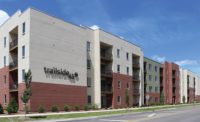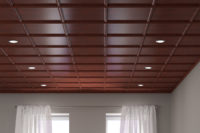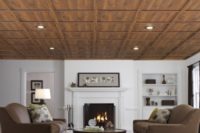Stucco is an attractive, durable and low maintenance exterior wall finish. Popular in residential and commercial construction, stucco provides a fire-resistive finish suitable for a variety of climates. Wood-based sheathing is often specified under stucco and when the proper material and installation procedures are followed, the results have been very satisfactory. Wood sheathing will generally be either plywood or oriented strand board. If installed incorrectly or exposed to high levels of moisture, wood sheathing will result in cracking to the stucco cladding.
Moisture Content
When we speak of acceptable levels of moisture content for wood products, the industry generally references a moisture content of 19 percent for Kiln-Dried KD or S-Dry for Surface-Dry at time of manufacture. Before the installation of gypsum wallboard, the NWCB and others recommend that the moisture content of lumber be no greater than 19 percent.
Wood swells as the moisture content increases and shrinks as the moisture content decreases. For every 4 percent change in moisture, lumber changes 1 percent in size. As lumber dries out, depending on the direction of the grain, lumber will twist, warp or compress. Twisting and warping will generally be displayed as “nail pops” or cracking in gypsum panels. Compression or shrinkage of lumber is most noticeable at the sill plates of floorlines or band joists. If a horizontal joint or gap in the wood sheathing—to allow for compression of sill plate members—is not provided at the floorline, buckling of the sheathing is likely to occur.
If a maximum of 19 percent moisture content is required for framing lumber, is it also appropriate for wood sheathing? Far too often the 19 percent moisture content reference is accepted for all wood products, but all wood products are not created equal. Whereas KD dimensional lumber is provided from the manufacture at 19 percent, the moisture content for wood structural panels from manufacture is generally in the range of 2 to 8 percent. In relation to dimensional lumber, the moisture content of wood structural panels is very low.
If your project happens to be in Southern California, Nevada, Arizona or other states with similar rainfall or relative humidity, chances are there will be no change to the moisture content from receipt to installation. That of course, is not the case when wood sheathing products are used in states with significant rainfall or high relative humidity such as the Northwest, Florida, or the Gulf Coast states.
Any of us that have used wood sheathing in moisture prone areas, understand that these wood panels can swell dramatically when their moisture content changes. Just how much and quickly the moisture content can change from 2 percent to 8 percent is provided by the American Plywood Association TT-028B. In a 12-hour period of wetting, the moisture content for ½-inch plywood goes from 8 percent to 30 percent. For 7/16-inch OSB, the moisture content goes from 2 percent to 14 percent. In 24-hours of wetting, the plywood moisture content goes to 35 percent and 22 percent for OSB. In 48-hours of wetting, the plywood moisture content swells to 46 percent and 30 percent for OSB. “When exposed to elevated humidity or wetting after manufacture, the resultant increase in moisture content leads to dimensional increase in thickness.”
Wood sheathing generally arrives at the jobsite with a moisture content in the 2-8 percent range, and is typically bundled and wrapped, protecting it from direct moisture contact. Once it is applied to the framing members and exposed to moisture in the form of rain or high humidity, the moisture content and dimensional stability can change dramatically. You may think, how can it move once it is nailed to the framing members and often times, shear nailed? The Answer: dramatically.
Buckle Down
Understanding the potential for linear expansion—increase in length and width—APA recommends that when plywood or OSB is installed, it be installed with a 1/8-inch gap around its entire perimeter. How many of you have seen this gap maintained when OSB or plywood is used for roofing underlayment? I would venture to say, always. The roofing industry understands completely what buckling of roof sheathing can do to the appearance of a shingled roof and no roofing contractor wants to go back and remove an entire roof of shingles and cut gaps into the roof sheathing that was omitted. No one, not anymore.
Now, how many of you have seen 1/8-inch gaps installed in plywood or OSB sheathing attached to the exterior wall? I would venture to say that few of you have because very seldom is the wood sheathing gapped on wall surfaces.
So, when you, as a stucco contractor, are called out to a completed project where your stucco is displaying cracking, what is the reaction of the General Contractor or Owner? It’s a bad stucco job. And you are directed to repair or replace the stucco. And how many of our stucco contractors go ahead and repair and replace the stucco without any compensation whatsoever? All too many.
I would argue that if your stucco was applied over wood framed construction with OSB or plywood sheathing, the wood sheathing was not gapped, blocking was not provided at the horizontal joints, and the sheathing was not installed perpendicular to the studs—in conformance to the recommendations of the American Plywood Association or manufacturer’s recommendations for stucco claddings. All are factors that could lead to buckling of the wood sheathing and subsequent cracking of stucco. What you will often see is that the cracks are somewhat uniform (generally horizontal and vertical cracking), a clear indicator that wood sheathing buckling has occurred.
Installation of the wood sheathing is also critical towards the performance of stucco cladding. Wood sheathing should be installed horizontally or perpendicular to the framing members. When sheathing is installed horizontally, APA recommends that blocking be installed between studs along horizontal panel joints, or fastening a plywood cleat to the back side of the wall sheathing with screws for extra support. Although, blocking is not always necessary to meet wall bracing requirements, it is recommended for the best performance, and to eliminate the potential for cracking of the stucco exterior finish along the horizontal joint in the wall sheathing. Blocking is required for shear wall applications.
It’s Not the Stucco
Plywood and OSB are very good products when protected from excess moisture and installed properly. But what is it going to take to get the general contractors to ensure that the wood sheathing is protected from excess moisture, ensure that the sheathing is gapped properly and installed perpendicular to framing and with blocking at the horizontal joints (per the recommendations of the American Plywood Association), and make certain that the moisture content is not excessive? Education, and if that fails, putting the responsibility and cost of repairs where it belongs. Before we mobilize to the project, we should send the superintendent to the project to observe the installation of the wood sheathing to make sure it is being installed correctly. If there are concerns over the installation of wood sheathing or observances of excess moisture, now is the time to raise them in writing to the GC.
I get a little tired of hearing people say, “Well it’s stucco, it’s supposed to crack.” Stucco doesn’t crack in a uniform pattern without some type of building movement. There is a reason we allow stucco to cure for fourteen to twenty days before we apply the finish coat. Most cracking that is going to occur will take the form of very small shrinkage cracking, think spider web cracking, during the curing stage. This is natural and these shrinkage cracks are easily addressed prior to the application of the finish coat, and again, this is why we let the brown coat cure out before applying the finish. But when it is thirty or sixty or more days since completion, and the owner has noticed cracks showing up, look to buckling as a source of cracking or some other type of building movement. And don’t be afraid to take a sample of the stucco and get it analyzed. More times than not the results are going to show nothing out of the ordinary with your stucco, which gives you the opportunity to say, it’s not the stucco.
Stucco is a fantastic wall cladding. By allowing others to blame stucco for cracking, when the real reason for cracking is the inability of others to be aware of, and strictly follow the manufactures recommendations for the installation of wood sheathings scheduled to receive stucco claddings, which does a disservice to our industry and to our craftspeople.






Report Abusive Comment